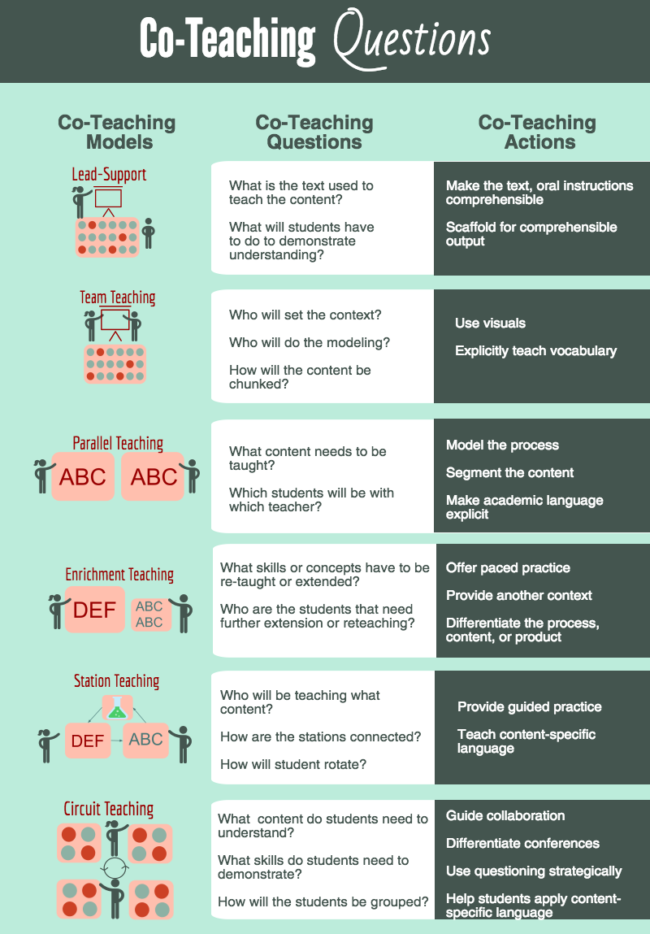 This article on questions to consider before co-teaching is Part 10 of the Collaboration for ELLs Series.
This article on questions to consider before co-teaching is Part 10 of the Collaboration for ELLs Series.
The first EAL (English as an Additional Language) team meeting we had after last year’s summer break was to set goals for the department. One of my colleagues said, “I want to research better program models for ELs… I feel like an overpaid aide. I sit in the back of the room and take notes. It’s a waste of my time and not effective for the ELs.”
After listening to his frustrations, I wanted to know how he used his co-planning time with the content teachers. When I co-teach in content classes, my teaching comes directly from our co-planning sessions. I see effective co-teaching as the fruit of productive co-planning.
But how can others know what questions to ask during co-planning to set up effective co-teaching?
The answer is two-fold:
- Keep a good set of guiding questions in mind during co-planning and
- Ask additional questions that fit the co-teaching model you’d like to use.
Guiding Questions
Sample Guiding Questions
- What’s the content that we want to teach?
- How will we structure the lessons?
- What are the language demands in the lesson?
- Who’s learning what, with whom, and when?
4 Things that Guiding Questions Help Teachers Determine
- the content,
- the lesson structure,
- the language demands, and
- student-teacher grouping.
Use We-Focused Language
These questions are for both the content and English language teacher (ELT) to answer. Instead of Question # 2 asking, “How does the content teacher want the lesson to be structured?”, it uses “we”-focused language to communicate a more collaborative approach where ELT can contribute to the lesson design.
Take Language Into Consideration
Notice how the sample questions above force teachers to consider language during co-planning. They help both teachers reflect on the texts during instruction and encourage conversations about:
- the content-specific language demands, and
- how will students be taught to use content-specific language.
Define Roles Based on Expertise
Lastly, these questions define the role of each teacher based on their area of expertise but recognize that you should be working with and for all students. As native-English speakers still need scaffolding to access content and communicate their understanding, the ELT should still work with them to make academic language visible. Additionally, the content teacher should learn strategies to deliver content to ELs.
Model-Specific Questions
The infographic provides a few more questions to ask during co-planning based on the co-teaching style. It’s not an exhaustive list, but just a collection of some questions to consider when collaborating. I will explain these particular styles of co-teaching more in a later article.
Co-Teaching is Directly Linked to Co-Planning
I bet you’re thinking: “Why are you sharing co-planning questions in an article about co-teaching?” Because co-teaching is directly linked to co-planning. Otherwise, the ELT becomes exactly like my colleague – an overpaid teacher’s aide. If co-planning is collaborative, then we will rarely see ELTs sitting in the back of the room taking notes.
The running theme among these guiding questions is collaboration. Content and ELTs each contribute from their area of expertise. The content teacher sets the context for learning, and the ELT brings an awareness and focus on making academic language accessible. These questions help guide their collaboration when co-teaching and maximize learning.
What are some questions you find helpful to ask during co-planning sessions?
Next Post
Now that we know how to ask specific questions during co-planning to inform our co-teaching, the next post will describe the indicators of effective co-teaching. There are three categories of indicators, and together, they support teachers in evaluating their co-teaching.

